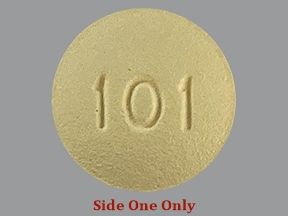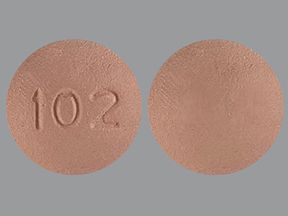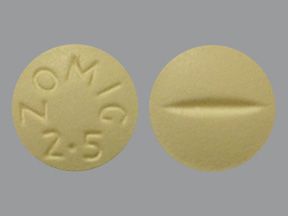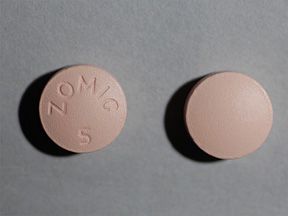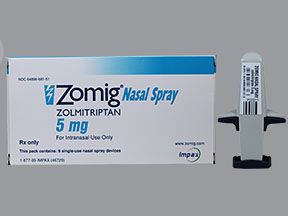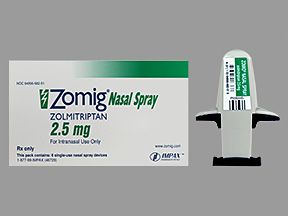Zomig is a brand-name drug that’s prescribed for treating migraine with or without aura. The medication is available in the following forms: nasal spray, oral tablets, and orally disintegrating tablets. Zomig belongs to the triptan drug class.
All forms of Zomig are FDA-approved to treat migraine in adults. The nasal spray is also approved to treat this condition in children ages 12 years and older.
Drug details
You’ll find key information about Zomig below.
- Drug forms: Nasal spray, oral tablet, orally disintegrating tablet*
- Generic available? Yes
- Prescription required? Yes
- Controlled substance? No
- Year of FDA approval: 1997
* Orally disintegrating tablets dissolve when placed in your mouth, either on or under your tongue.
Zomig is a brand-name drug that contains the active drug zolmitriptan. This active drug is also available as a generic medication. A generic drug is an exact copy of the active drug in a brand-name medication. A generic form of zolmitriptan is available as a nasal spray, oral tablet, and orally disintegrating tablet.
The generic is considered to be as safe and effective as the original drug. Generics tend to cost less than brand-name drugs.
If you’re interested in using the generic tablet form of Zomig, talk with your doctor. They can tell you whether it comes in forms and strengths that can be used for your condition.
Zomig can cause mild or serious side effects. The following lists contain some of the key side effects that may occur while taking Zomig. These lists do not include all possible side effects.
For more information about the possible side effects of Zomig, see this article. You can also talk with your doctor or pharmacist. They can give you tips on how to manage any side effects that may be concerning or bothersome.
Note: The Food and Drug Administration (FDA) tracks side effects of drugs it has approved. If you would like to notify the FDA about a side effect you’ve had with Zomig, you can do so through MedWatch.
Mild side effects
Mild side effects* of Zomig nasal spray and tablets can include:
- a cold, heavy, or warm sensation in your body
- dry mouth
- nausea
- numbness or tingling in the arms or legs
- sleepiness
- upset stomach
- weakness
- dizziness†
Additional mild side effects reported by people using only Zomig nasal spray include:
- discomfort or irritation in the nose
- increased skin sensitivity to sensations, such as touch or pain
- throat pain
- unusual taste
Most of these side effects may go away within a few days to a couple of weeks. But if they become more severe or don’t go away, talk with your doctor or pharmacist.
* This is a partial list of mild side effects from Zomig. To learn about other mild side effects, talk with your doctor or pharmacist, or view prescribing information for Zomig nasal spray and tablets.
† For more information about this side effect, see “Side effect details” below.
Serious side effects
Serious side effects from Zomig aren’t common, but they can occur. Call your doctor right away if you have serious side effects. Call 911 or your local emergency number if your symptoms feel life threatening or if you think you’re having a medical emergency.
Serious side effects and their symptoms can include:
- Bleeding in the brain or stroke. Symptoms can include:
- Blood vessel problems, such as vasospasm (sudden narrowing of arteries). Symptoms vary depending on where in the body the problem occurs, but can include:
- abdominal pain
- chest pain
- numbness or weakness in your arms or legs
- vision problems, including vision loss
- Heart attack. Symptoms can include:
- severe pain, pressure, or tightness in your chest, which may also affect your jaw, neck, throat, arms, or back
- feeling clammy or sweaty
- nausea and sometimes vomiting
- shortness of breath
- Heart arrhythmias. Symptoms can include:
- chest pain
- dizziness
- fainting
- heart palpitations
- Medication overuse headache.*
- Raynaud’s disease (lack of blood flow to your nose, ears, fingers, or toes). Symptoms can include:
- numbness, coldness, or pain in your fingers or toes
- fingers or toes that turn pale or blue in response to cold or stress, then red as blood flow returns
- Serotonin syndrome (a high level of the chemical serotonin). Symptoms can include:
- excessive sweating
- fast heart rate
- feeling agitated or anxious
- muscle spasms or rigidity
- nausea and vomiting
- restlessness
- Allergic reaction.†
- High blood pressure.†
- Upper body tightness or pressure.†
* For more information, see the “Zomig withdrawal and dependence” section below.
† For more information about this side effect, see “Side effect details” below.
Side effects in children
Zomig nasal spray is approved to treat migraine headache in adults and children 12 years and older. Side effects in children in clinical trials were the same as those reported by adults in the trials.
For more information, see the “Mild side effects” and “Serious side effects” sections above.
Note: Zomig oral tablets and orally disintegrating tablets are approved for use only in adults.
Side effect details
Here’s some detail on certain side effects this drug may cause. To find out how often side effects occurred in clinical trials, see Zomig’s prescribing information for nasal spray and tablets.
High blood pressure
The use of Zomig may raise blood pressure. High blood pressure was a reported side effect in the drug’s clinical trials.
Most people who reported this side effect had very small increases in blood pressure. Typically, high blood pressure doesn’t cause symptoms, unless it’s severe. And severely high blood pressure is extremely rare with Zomig. However, people with liver problems who had this side effect did report large blood pressure increases in some cases.
Symptoms of severely high blood pressure may include:
- chest pain
- confusion
- nosebleed
- severe headache
- shortness of breath
If you experience any of these symptoms, contact your doctor right away. Or seek emergency medical help if your symptoms feel life threatening.
While taking Zomig, your doctor will monitor your blood pressure. They may also suggest you monitor your blood pressure at home. Talk with your doctor to learn more about how you should monitor your blood pressure.
If you’re concerned about having increased blood pressure while taking Zomig, talk with your doctor. They can discuss your risk for this side effect.
Upper body tightness or pressure
Upper body tightness or pressure was among the more common side effects reported by people who used Zomig in clinical trials. This typically affects the jaw, throat, neck, or chest.
In most cases, this side effect isn’t serious. However, upper body tightness or pressure can also be a symptom of more serious side effects, such as a heart attack.
Heart attacks rarely occur with the drug. However, you should talk with your doctor right away if you have upper body tightness or pressure while taking Zomig. Or seek emergency medical help if your symptoms feel life threatening.
Dizziness
Dizziness may occur with Zomig. This side effect was common in the drug’s clinical trials.
In most cases, the dizziness is mild and goes away on its own. However, dizziness can also be a symptom of more serious side effects. An example is heart arrhythmia, which is a serious side effect of Zomig.
If you have dizziness that doesn’t go away or bothers you, talk with your doctor. They may want to check to see whether this is a symptom of a more serious side effect. They may also recommend trying a different medication for your migraine.
Allergic reactionAs with most drugs, some people can have an allergic reaction after taking Zomig.
Symptoms of a mild allergic reaction can include:
A more severe allergic reaction is rare but possible. Symptoms of a severe allergic reaction can include:
- swelling under your skin, typically in your eyelids, lips, hands, or feet
- swelling of your tongue, mouth, or throat
- trouble breathing
Call your doctor right away if you have an allergic reaction to Zomig, as the reaction could become severe. Call 911 or your local emergency number if your symptoms feel life threatening or if you think you’re having a medical emergency.
The Food and Drug Administration (FDA) approves prescription drugs such as Zomig to treat certain conditions.
Zomig for migraine
Zomig is approved to treat migraine with or without aura.
Zomig nasal spray is approved for use in adults and children ages 12 and older. Zomig oral tablets are approved for use in adults. The tablets are available as oral tablets (Zomig) that you swallow and as orally disintegrating tablets (Zomig-ZMT) that dissolve on your tongue.
Keep in mind that you should not take Zomig unless a doctor has determined you have migraine. The drug is to be used only as needed to treat migraine. Zomig should not be taken to help prevent migraine.
It’s also important to note that Zomig is not approved to treat cluster headaches. In addition, Zomig nasal spray and Zomig-ZMT typically aren’t recommended for people who have moderate to severe liver problems.
Migraine explained
Migraine is a condition characterized by severe headaches. Other symptoms can include nausea and vomiting and sensitivity to light or sound.
Some people have certain symptoms around or at the time of the headache. These symptoms are called aura. Aura symptoms can include seeing flashes of light or feeling a pins and needles sensation in your arms and legs.
You can learn more about migraine by visiting our headache and migraine hub.
Effectiveness for migraine
Clinical trials showed Zomig to be effective for treating migraine. To learn more about how the drug performed in these trials, check out the prescribing information for Zomig nasal spray and tablets. You can also talk with your doctor or pharmacist to learn more.
Triptan medications, including Zomig, are recommended by the American Academy of Neurology as a treatment for migraine.
Zomig and children
Zomig nasal spray is approved for treating migraine headache in adults and children ages 12 and older. However, Zomig tablets (including orally disintegrating tablets) are only approved for use in adults.
The Zomig dosage your doctor prescribes will depend on several factors. These include:
- the severity of the condition you’re using Zomig to treat
- your age
- the form of Zomig you take
- other medical conditions you may have
- other medications you may take
Typically, your doctor will start you on a low dosage. Then they’ll adjust it over time to reach the amount that’s right for you. Your doctor will ultimately prescribe the smallest dosage that provides the desired effect.
The following information describes dosages that are commonly used or recommended. However, be sure to take the dosage your doctor prescribes for you. Your doctor will determine the best dosage to fit your needs.
For more details about Zomig’s dosage, see this article.
Drug forms and strengths
Zomig nasal spray is approved for use in adults and children ages 12 and older. Zomig tablets are approved for use in adults. The tablets are available as oral tablets (Zomig) that you swallow and as orally disintegrating tablets (Zomig-ZMT) that dissolve on your tongue.
All three forms are available in two strengths: 2.5 milligrams (mg) and 5 mg.
The form of Zomig you’ll use depends on several factors. This includes your age and other medical conditions you have.
For example, Zomig tablets are only approved for use in adults. And Zomig nasal spray and Zomig-ZMT typically aren’t recommended for people who have moderate to severe liver problems.
Also, doctors typically won’t prescribe Zomig-ZMT for people who have a genetic (inherited) condition called phenylketonuria. For more information, see the “Zomig precautions” section below.
Talk with your doctor about the form of Zomig that’s best for you.
Dosage for migraine
If you are using Zomig nasal spray to treat your migraine, your doctor will likely start with a dose of 2.5 mg. This would consist of one spray of the 2.5-mg strength. (There’s only one dose in each nasal sprayer.) If your migraine doesn’t ease with this dose, your doctor may increase the dose to a maximum dose of 5 mg.
If you are using Zomig tablets to treat your migraine, your doctor will likely start with a dose of 1.25 mg or 2.5 mg. You would take a 1.25-mg dose by splitting a 2.5-mg tablet in half. If your migraine doesn’t ease with this dose, your doctor may increase it to a maximum dose of 5 mg.
You should take a Zomig dose only as needed when you’re having a migraine headache. You may take a second dose if it’s been 2 hours since your first dose and either:
- your migraine hasn’t gone away
- your migraine went away but has come back
The maximum dose over a 24-hour period is 10 mg. However, if you have moderate or severe liver problems, your maximum dose would be lower. For more information, see the “Zomig precautions” section below.
Children’s dosage
Zomig nasal spray is approved for use in children ages 12 and older, as well as adults, to treat migraine headache. The recommended starting dose is 2.5 mg. A second dose may be given 2 hours later if the migraine hasn’t gone away or goes away but comes back.
Will I need to use this drug long term?
Zomig is meant to be used as a long-term treatment. If you and your doctor determine that Zomig is safe and effective for you, you’ll likely take it long term.
However, it’s important to remember that Zomig isn’t meant to be used every day. It’s not known how safe it is to use Zomig nasal spray to treat more than four migraine episodes within a 30-day period. And it’s not known how safe it is to use Zomig tablets to treat more than three migraine episodes within a 30-day period.
Talk with your doctor if you use Zomig frequently. They may suggest a different treatment option that would be better for you.
Here are answers to some frequently asked questions about Zomig.
Are there any side effects from long-term use of Zomig?
Medication overuse headache is a potential side effect from long-term use of Zomig, but it’s rare.
This side effect typically happens only when:
- Zomig nasal spray is used to treat more than four migraine episodes in a month
- Zomig tablets are used to treat more than three migraine episodes in a month
For more information on Zomig and medication overuse headache, see the “Zomig withdrawal and dependence” section below.
If you have additional questions about Zomig and long-term side effects, talk with your doctor or pharmacist.
What side effects does Zomig nasal spray cause?
In clinical trials, Zomig nasal spray caused many of the same side effects as Zomig tablets. To learn more, see the “Zomig side effects” section above.
There were also some additional mild side effects reported only by people who used Zomig nasal spray. These side effects included:
- discomfort or irritation in the nose
- increased skin sensitivity to sensations, such as touch or pain
- throat pain
- unusual taste
For all the side effects reported by people who took Zomig nasal spray in clinical trials, see the drug’s full prescribing information. You can also talk with your doctor or pharmacist to learn more.
Is Zomig a controlled substance? Will it make me feel ‘high’?
No, Zomig isn’t a controlled substance. Taking it won’t make you feel “high.” A controlled substance is a drug that the government regulates because taking it can lead to misuse and dependence. Misuse means taking a drug in a way other than how a doctor prescribes it. Dependence means your body becomes used to a drug and needs it to function as usual.
Other medications used to treat migraine are controlled substances. One example is tramadol (Ultram).
Also, the euphoria (intense feelings of happiness) that some controlled substances can cause is a reported side effect with rizatriptan benzoate (Maxalt). Like Zomig, this is a triptan drug used to treat migraine. However, euphoria hasn’t been reported with Zomig.
Talk with your doctor if you have questions about Zomig’s side effects.
Other drugs are available that can treat migraine headache. Some may be a better fit for you than others. If you’re interested in finding an alternative to Zomig, talk with your doctor. They can tell you about other medications that may work well for you.
Note: Some of the drugs listed here are used off-label to treat these specific conditions. Off-label drug use is when a drug that’s approved by the Food and Drug Administration (FDA) is used for a purpose other than what it’s approved for.
Alternatives for migraine
Examples of other drugs that may be used to treat migraine headache include:
- other triptan medications, such as:
- eletriptan (Relpax)
- rizatriptan (Maxalt and Maxalt-MLT)
- sumatriptan (Imitrex)
- sumatriptan/naproxen (Treximet)
- anti-inflammatory and pain medications, such as:
- acetaminophen (Tylenol)
- ibuprofen (Advil)
- naproxen (Aleve)
- tramadol (Ultram)
- butalbital/acetaminophen/caffeine
- butalbital/aspirin/caffeine (Fiorinal)
- lasmiditan (Reyvow)
- ergot drugs, such as:
- dihydroergotamine (Migranal)
- ergotamine tartrate (Ergomar)
- ergotamine/caffeine (Migergot)
As with all medications, the cost of Zomig can vary. The actual cost you’ll pay depends on your insurance plan, your location, and the pharmacy you use. This includes the cost per pill if you’re prescribed Zomig tablets.
Keep in mind that you may be able to get a 90-day supply of Zomig. If approved by your insurance company, getting a 90-day supply of the drug could reduce your number of trips to the pharmacy and help lower the cost. If you’re interested in this option, check with your doctor, pharmacist, or insurance company.
Before approving coverage for Zomig, your insurance company may require you to get prior authorization. This means that your doctor and insurance company will need to communicate about your prescription before the insurance company will cover the drug. The insurance company will review the prior authorization request and decide whether the drug will be covered.
If you’re not sure whether you’ll need to get prior authorization for Zomig, contact your insurance company.
Financial and insurance assistance
If you need financial support to pay for Zomig, or if you need help understanding your insurance coverage, help is available.
You may find details about drug assistance programs that help cover the cost of Zomig at these websites: NeedyMeds and Medicine Assistance Tool.
To learn more about saving money on prescriptions, check out this article.
Mail-order pharmacies
Zomig may be available through a mail-order pharmacy. Using this service may help lower the drug’s cost and allow you to get your medication without leaving home.
If recommended by your doctor, you may be able to receive a 90-day supply of Zomig, so there’s less concern about running out of the medication. If you’re interested in this option, check with your doctor, pharmacist, or insurance company. Some Medicare plans may help cover the cost of mail-order medications.
If you don’t have insurance, you can ask your doctor or pharmacist about online pharmacy options.
Generic version
Zomig nasal spray, oral tablet, and orally disintegrating tablet are available in a generic form called zolmitriptan. A generic drug is an exact copy of the active drug in a brand-name medication. The generic is considered to be as safe and effective as the original drug. And generics tend to cost less than brand-name drugs.
If your doctor has prescribed Zomig and you’re interested in using zolmitriptan instead, talk with your doctor. They may have a preference for one version or the other. You’ll also need to check your insurance plan, as it may only cover one or the other.
Zomig can interact with several other medications.
Different interactions can cause different effects. For instance, some interactions can interfere with how well a drug works. Other interactions can increase side effects or make them more severe.
Zomig and other medications
Below is a list of medications that can interact with Zomig. This list does not contain all drugs that may interact with Zomig.
Before taking Zomig, talk with your doctor and pharmacist. Tell them about all prescription, over-the-counter, and other drugs you take. Also tell them about any vitamins, herbs, and supplements you use. Sharing this information can help you avoid potential interactions.
If you have questions about drug interactions that may affect you, ask your doctor or pharmacist.
Drugs that should not be used with Zomig
Drugs that you should not take with Zomig include:
- Ergot drugs. These are another type of medication used to treat migraine. Taking Zomig with an ergot drug can increase your risk of blood vessel problems,* a side effect of Zomig. Examples of ergot drugs include:
- dihydroergotamine (Migranal)
- ergotamine tartrate (Ergomar)
- ergotamine/caffeine (Migergot)
- Monoamine oxidase inhibitors. Taking Zomig with a monoamine oxidase inhibitor (MAOI) can increase your risk of side effects* from Zomig, including serious ones. Examples of MAOI drugs include:
- selegiline (Emsam, Zelapar)
- isocarboxazid (Marplan)
- phenelzine (Nardil)
- Other triptan medications. Taking Zomig with another triptan drug can increase your risk of side effects* from Zomig, including serious ones. Examples of triptan drugs include:
- rizatriptan (Maxalt and Maxalt-MLT)
- sumatriptan (Imitrex)
- sumatriptan/naproxen (Treximet)
- Acetaminophen. Taking acetaminophen (Tylenol) while taking Zomig may cause acetaminophen to work slightly slower than usual.
* For more details about side effects, see the “Zomig side effects” section above.
Other drugs that may interact with Zomig
Other medications that may interact with Zomig include:
- Antidepressants. Certain antidepressants may raise your risk for serotonin syndrome (a high level of chemical serotonin) when used with Zomig. These include:
- selective serotonin reuptake inhibitors (SSRIs), such as sertraline (Zoloft)
- serotonin-norepinephrine reuptake inhibitors (SNRIs), such as duloxetine (Cymbalta)
- Cimetidine. Taking Zomig with cimetidine (Tagamet HB) can increase your risk of side effects from Zomig. If you take cimetidine, your doctor may prescribe a lower dosage of Zomig than usual.
Zomig and herbs and supplements
There aren’t any herbs or supplements that have been specifically reported to interact with Zomig. However, you should still check with your doctor or pharmacist before using any of these products while taking Zomig.
Zomig and foods
There aren’t any foods that have been specifically reported to interact with Zomig. If you have any questions about eating certain foods with Zomig, talk with your doctor.
There’s no known interaction between drinking alcohol and taking Zomig.
Keep in mind that drinking alcohol can trigger migraine headaches in some people.
If you drink alcohol and have questions about how it may affect your migraine, talk with your doctor. They can advise you on how much is safe for you to consume.
You should take Zomig according to the instructions your doctor gives you.
Zomig is available in three different forms: oral tablets, orally disintegrating tablets, and a nasal spray.
How to take Zomig oral tablets
Zomig oral tablets are tablets that you swallow.
How to take Zomig orally disintegrating tablets
Zomig-ZMT orally disintegrating tablets should be placed on your tongue, where they’ll dissolve.
Be sure to not remove the disintegrating tablets from their blister pack until you’re ready to take a dose. If small pieces of a tablet break off in the packaging, you can safely throw these away.
How to use Zomig nasal spray
You’ll use Zomig nasal spray by spraying it into one nostril. You can find step-by-step instructions in the “Instructions for use” section of the drug’s prescribing information.
Keep in mind that you should not prime Zomig nasal spray. Each sprayer contains only one dose. You’ll lose the dose if you prime the Zomig nasal sprayer. (To “prime” means to squirt the nasal spray into the air until a mist comes out.)
When to take
Whichever form of Zomig you use, you’ll take a dose only as needed when you start to have migraine symptoms.
If your migraine symptoms don’t go away, you may take a second dose if it’s been 2 hours since your first dose and either:
- your symptoms haven’t gone away
- your symptoms went away but have come back
Zomig is not meant to be used every day. It’s also not known whether it’s safe to use Zomig nasal spray to treat more than four migraine episodes within a 30-day period. In addition, it’s not known how safe it is to use Zomig tablets to treat more than three migraine episodes within a 30-day period.
Talk with your doctor if you use Zomig frequently. They may suggest a different treatment option that would be better for you.
Accessible labels and containers
If your prescription label is hard to read, talk with your doctor or pharmacist. Some pharmacies offer labels that have large print, braille, or a code you scan with a smartphone to convert text to speech. If your local pharmacy doesn’t have these options, your doctor or pharmacist may be able to direct you to one that does.
Taking Zomig with food
You may take a Zomig dose with or without food.
Can Zomig be crushed, split, or chewed?
It depends. Zomig oral tablets with a 2.5-milligram (mg) strength have a “score” on them so they can be split in half. Neither the 5-mg oral tablets nor the orally disintegrating tablets have this scoring.
You should not crush, split, or chew Zomig-ZMT orally disintegrating tablets. The whole tablet should be placed on your tongue, where it will dissolve.
If you have trouble swallowing Zomig oral tablets, talk with your doctor or pharmacist about switching to the orally disintegrating tablet or nasal spray.
Zomig is approved to treat migraine headache.
Migraine is a condition characterized by severe headaches. Other symptoms can include nausea and vomiting, and sensitivity to light or sound.
Some people also have certain symptoms around or at the time of the headache. These symptoms are called aura. Aura symptoms can include seeing flashes of light or feeling a pins and needles sensation in your arms and legs. Zomig may be used to treat migraine with or without aura.
What causes migraine isn’t fully understood. It’s thought to be due to swollen blood vessels in your head.
Zomig works by increasing serotonin levels in your brain. Serotonin is a chemical your body makes and has many functions in your body. A few examples include mood, appetite, and digestion.
In the brain, serotonin can bind to receptors on blood vessels. (Receptors are proteins on the outside of cells that act like docking stations.) This causes blood vessels in the brain to narrow, which can reduce swelling and relieve migraine symptoms.
How long does it take to work?
Zomig should reduce migraine symptoms within 2 hours of taking a dose, although some people may feel relief sooner.
It’s not known whether it’s safe to take Zomig while pregnant. Animal trials showed a risk of congenital anomalies (commonly known as birth defects) or loss of pregnancy. However, animal trials don’t always predict what will happen in people.
It’s important to note that being diagnosed with migraine may mean you have an increased risk of preeclampsia. This is a pregnancy complication in which you have high blood pressure.
Talk with your doctor about safe treatments for your migraine if you’re pregnant or planning to become pregnant.
It’s not known whether Zomig is safe to take during pregnancy. If you’re sexually active and you or your partner can become pregnant, talk with your doctor about your birth control needs while you’re using Zomig.
For more information about taking Zomig during pregnancy, see the “Zomig and pregnancy” section above.
It’s not known whether it’s safe to breastfeed while taking Zomig. This is because it’s not known whether the drug passes into breast milk or whether it could cause side effects in a child who is breastfed.
Talk with your doctor about safe feeding options for your child if you take Zomig. They may also be able to suggest other treatments.
This drug comes with several precautions. Before taking Zomig, talk with your doctor about your health history. Zomig may not be right for you if you have certain medical conditions or other factors affecting your health. These include the ones mentioned below.
Note: For more information about the potential negative effects of Zomig, see the “Zomig side effects” section above.
Blood circulation problems. Doctors typically will not prescribe Zomig if you have problems with blood circulation. This is because Zomig can cause blood vessel problems as a side effect, which could worsen your condition. Ask your doctor about other medications that might be better options for you.
Stroke. Doctors typically will not prescribe Zomig if you’ve had a stroke in the past. In rare cases, Zomig can cause stroke and other blood vessel problems. If you’ve had a stroke, your risk for these side effects may increase. Ask your doctor about other medications that might be better options for you.
Serious liver problems. Doctors typically will not prescribe Zomig if you have serious liver problems. Your body uses your liver to get rid of Zomig after you take a dose. If you have serious liver problems, your body may not be able to get rid of Zomig effectively. This can cause the drug to build up in your system, increasing your risk of side effects. Ask your doctor what other drugs might be better options.
High blood pressure that isn’t managed. Doctors typically will not prescribe Zomig if you have high blood pressure that isn’t managed. Zomig can raise blood pressure as a side effect. This can be unsafe if you already have high blood pressure that isn’t managed. Ask your doctor what other migraine medications might be better options for you. They can also discuss treatments to help manage high blood pressure.
Heart disease. Doctors typically will not prescribe Zomig if you have heart disease. This includes conditions such as coronary artery disease, coronary artery spasm, and Prinzmetal’s angina. The drug can cause heart problems, including heart attack. If you already have heart disease, your risk for heart problems may increase. Ask your doctor about other treatments that might be better choices for you.
Risk factors for heart disease. Taking Zomig can cause side effects involving your heart and blood vessels. You may be at an increased risk for these side effects if you have risk factors for heart disease, even if you don’t have heart disease. Risk factors for heart disease include having high cholesterol, diabetes, and obesity. They also include menopause, smoking or tobacco use, and family history of heart disease or stroke.
Talk with your doctor to learn more about how safe Zomig is for you to take. If your doctor decides to prescribe Zomig to you, they may monitor your heart health closely.
Phenylketonuria. Zomig-ZMT (orally disintegrating tablet) contains an ingredient called phenylalanine. For this reason, your doctor may not prescribe Zomig-ZMT for you if you have phenylketonuria (PKU). PKU is a genetic (inherited) condition that leads to a high level of phenylalanine in the body. Your doctor may prescribe Zomig oral tablets or Zomig nasal spray instead. These forms of Zomig don’t contain phenylalanine.
Allergic reaction. If you’ve had an allergic reaction to Zomig or any of its ingredients, your doctor will likely not prescribe Zomig. Ask your doctor what other medications could be better options for you.
Pregnancy. It’s not known whether it’s safe to take Zomig while pregnant. For more information, see the “Zomig and pregnancy” section above.
Breastfeeding. It isn’t known whether it’s safe to breastfeed while taking Zomig. For more information, see the “Zomig and breastfeeding” section above.
Do not use more Zomig than your doctor recommends. For some drugs, doing so may lead to unwanted side effects or overdose.
What to do in case you take too much Zomig
If you think you’ve taken too much of this drug, call your doctor. You can also call America’s Poison Centers at 800-222-1222 or use its online tool. But if your symptoms are severe, call 911 or your local emergency number, or go to the nearest emergency room right away.
There haven’t been clinical trials on whether Zomig can cause drug dependence. With drug dependence, your body needs the drug to feel as it usually would. And withdrawal symptoms are side effects that can occur when you stop taking a drug that your body has become dependent on.
However, overuse of Zomig may lead to medication overuse headache (MOH). This side effect occurs when you take too much of the drug over a short period of time. Zomig nasal spray should not be used to treat more than four migraine episodes per month. And Zomig tablets should not be taken to treat more than three migraine episodes per month.
Symptoms of MOH can include daily migraine headaches or more frequent migraine episodes than usual.
If you take Zomig and develop MOH from overuse, your doctor will likely have you stop Zomig treatment. Once treatment is stopped, you may experience withdrawal symptoms (such as worsening of MOH) due to overuse of the medication.
It’s important to take Zomig only as your doctor prescribes. Clinical trials did not find any withdrawal associated with Zomig when the drug was taken correctly. To learn more, see the “Zomig dosage” section above.
If you take Zomig more often than is recommended, talk with your doctor. They can advise you on ways to help prevent migraine episodes. Your doctor can also determine whether Zomig is the right medication for you.
When you get Zomig from the pharmacy, the pharmacist will add an expiration date to the label on the packaging. This date is typically 1 year from the date they dispensed the medication.
The expiration date helps guarantee that the medication is effective during this time. The
Storage
How long a medication remains good to use can depend on many factors, including how and where you store the medication.
You should store Zomig oral tablets and Zomig-ZMT orally disintegrating tablets at room temperature in a tightly sealed container away from light. Avoid keeping this medication in areas where it could get damp or wet, such as bathrooms. Zomig nasal spray doesn’t need to be protected from light, but it needs to be stored at room temperature.
Disposal
If you no longer need to take Zomig and have leftover medication, it’s important to dispose of it safely. This helps prevent others, including children and pets, from taking the drug by accident. It also helps keep the drug from harming the environment.
This article provides several useful tips on medication disposal. You can also ask your pharmacist for information about how to dispose of your medication.
Disclaimer: Medical News Today has made every effort to make certain that all information is factually correct, comprehensive, and up to date. However, this article should not be used as a substitute for the knowledge and expertise of a licensed healthcare professional. You should always consult your doctor or another healthcare professional before taking any medication. The drug information contained herein is subject to change and is not intended to cover all possible uses, directions, precautions, warnings, drug interactions, allergic reactions, or adverse effects. The absence of warnings or other information for a given drug does not indicate that the drug or drug combination is safe, effective, or appropriate for all patients or all specific uses.

